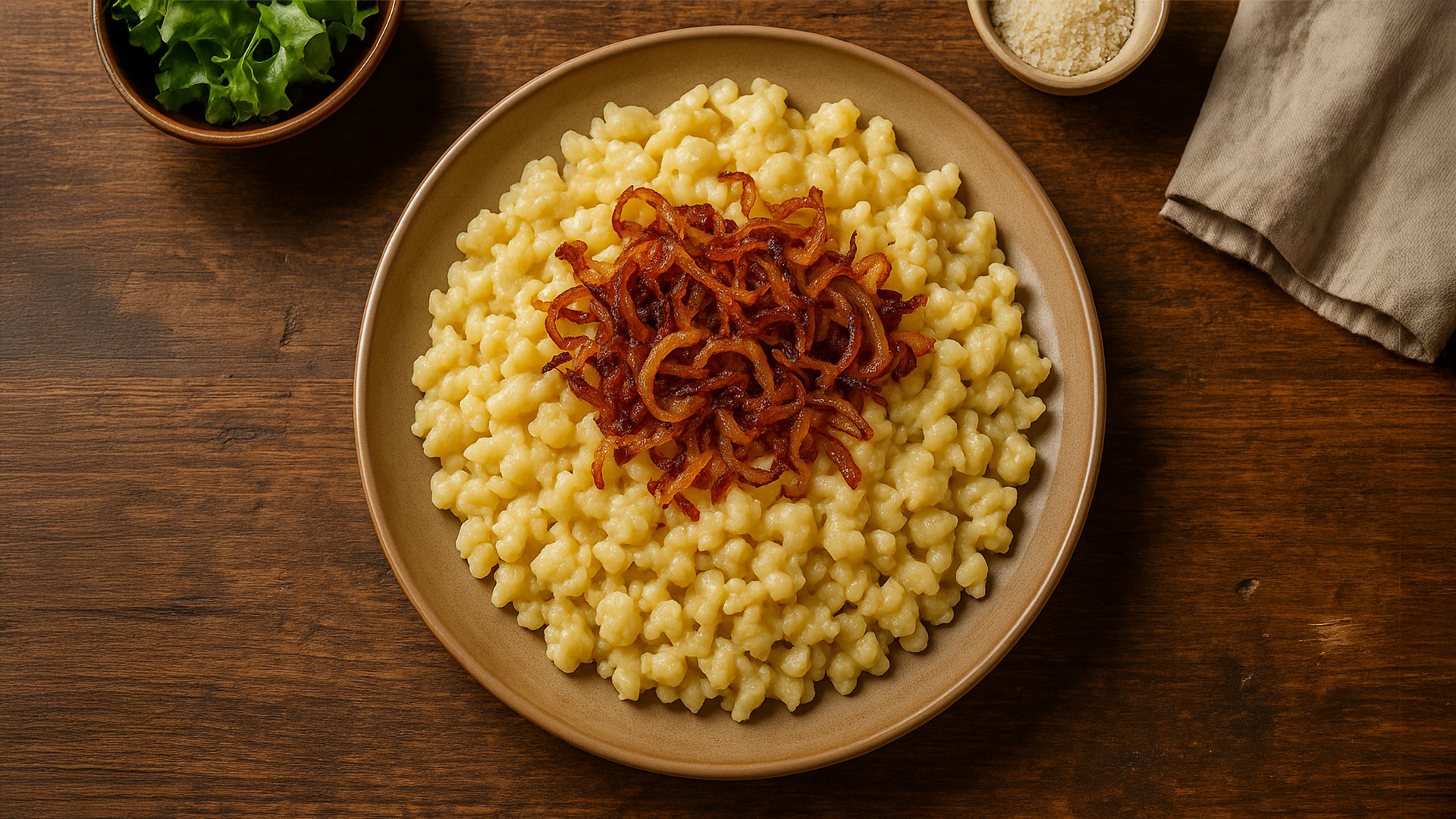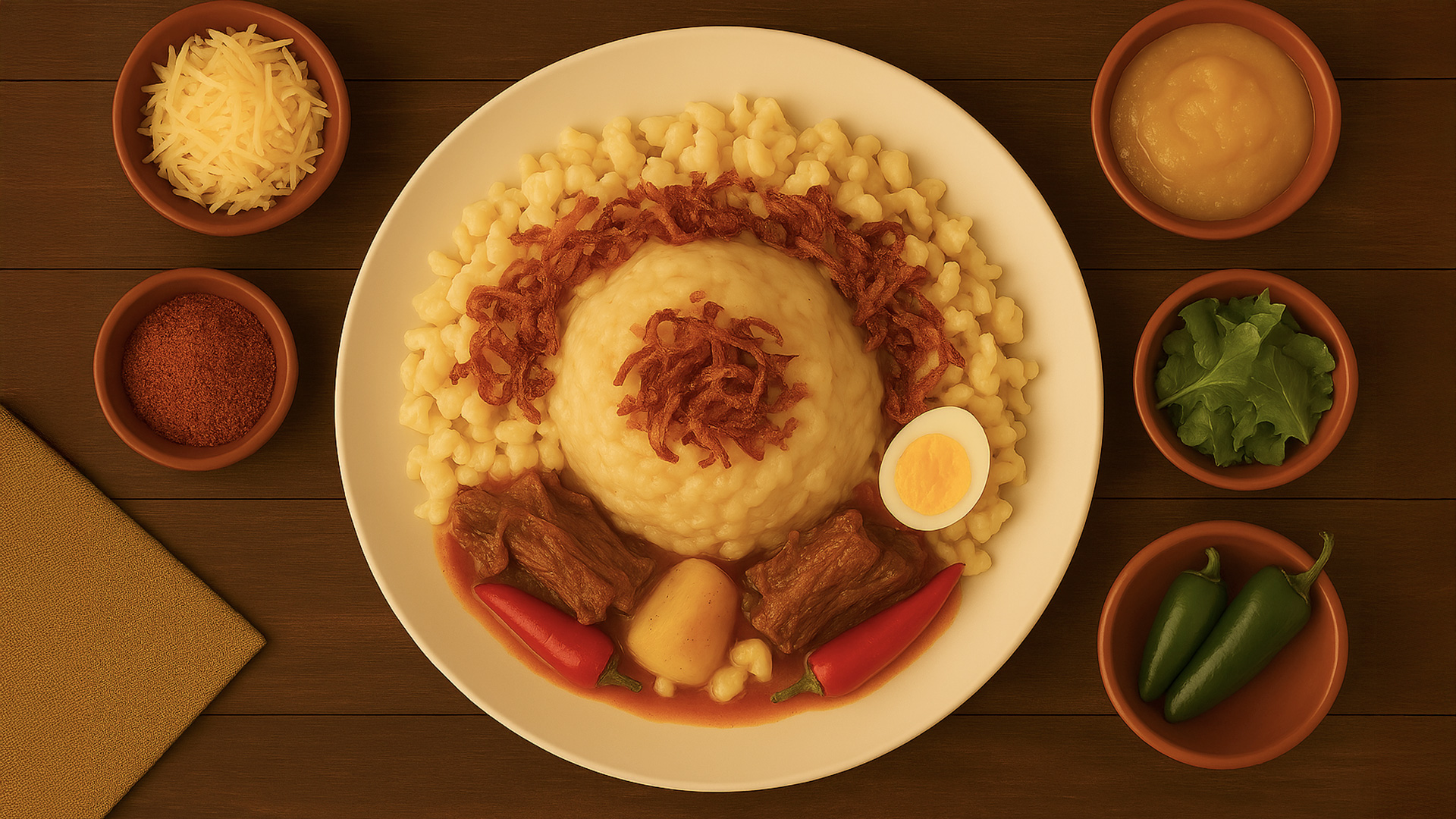Located in the heart of the Alps, Käsknöpfle is Liechtenstein's take on comfort food that soothes the soul. It combines rich mountain cheese with pillowy dumplings. Imagine a surprising side of sweet applesauce to balance out all that savory decadence, and golden-fried onions to add the ideal crunch. Like a ski chalet hug for your taste buds, it's cozy, rustic, and unabashedly cheesy! Read More...
The History of Liechtenstein’s National Dish – Käsknöpfle (Cheese Dumplings with Caramelized Onions):
Nestled between Switzerland and Austria, the tiny principality of Liechtenstein has a rich alpine culture and cuisine that blends the best of its neighbors’ traditions. Among its culinary treasures, Käsknöpfle — soft egg noodles smothered in cheese and topped with crispy onions — proudly stands out as the country’s beloved national dish. With humble origins and hearty ingredients, Käsknöpfle reflects Liechtenstein’s rural past and enduring love for comfort food that warms both the stomach and the soul.
Origins in Alpine Simplicity:
The roots of Käsknöpfle trace back to the Alpine regions of Germany, Austria, and Switzerland, where similar dishes like Spätzle or Älplermagronen emerged as affordable, filling meals for farming families. In Liechtenstein, the dish took on its own character through local cheese blends and preparation styles.
The word Knöpfle means “little buttons” in German, referring to the shape of the soft, doughy noodles made by pressing an egg-flour batter through a grater or colander into boiling water. These tender dumplings are then layered with a blend of regional cheeses — often Appenzeller, Emmental, and Gruyère — to create a rich, melty dish that’s simple yet deeply satisfying.
From Farmhouse Fare to National Favorite:
Käsknöpfle was originally a working-class meal, prepared in rural kitchens across Liechtenstein using basic pantry staples: flour, eggs, cheese, and onions. The onions were slowly caramelized in a skillet to add a savory topping, and the dish was often served with applesauce or salad — an unexpected but beloved side that lightens the richness of the cheese.
Over time, Käsknöpfle grew in status from peasant fare to a national symbol of home and heritage. It became a staple at family gatherings, local taverns, and national celebrations, where it’s enjoyed by everyone from schoolchildren to royalty.
A Taste of Identity:
In a country with no Michelin-starred restaurants but a strong commitment to culinary tradition, Käsknöpfle is both comforting and culturally significant. It showcases Liechtenstein’s connection to its alpine roots and the shared culinary language of Central Europe, while still remaining distinctly local.
Today, Käsknöpfle is proudly served in homes and eateries across Liechtenstein — often with secret family cheese blends or homemade apple sauces. It is also celebrated during culinary festivals and cultural showcases, representing the heart and flavor of the nation.
More Than a Meal:
Käsknöpfle is more than just a plate of cheesy noodles; it’s a dish that connects generations, tells stories of alpine life, and brings people together over bubbling pots and crispy onions. In its simplicity lies its power — a national dish that remains beloved, unpretentious, and unmistakably Liechtensteiner.
Make the Dough:
Caramelize the Onions:
Cook the Knöpfle:

Assemble the Dish:
Serve:

Tips & Notes:
The total preparation and cooking time for Käsknöpfle is approximately 50 minutes. Preparing the dough takes about 10 minutes, followed by a 10–15 minute resting period to help the batter relax. While the dough rests, you can caramelize the onions, which takes around 15–20 minutes over low heat. Cooking the Knöpfle in boiling water, in batches, requires another 10–15 minutes, depending on the size of your pot. Assembling the final dish—layering hot dumplings with cheese and topping it with onions—takes just a few more minutes. With some multitasking, the entire dish can be ready in under an hour.
A single serving of Käsknöpfle, based on the traditional recipe provided, contains approximately 600–750 calories. The dumplings made from flour and eggs contribute about 300–350 calories, while the cheese layer — a rich blend of Emmental, Gruyère, and Appenzeller — adds around 250–300 calories, depending on quantity and fat content. The caramelized onions, sautéed in butter, contribute another 50–100 calories. If served with a side of applesauce (about ½ cup), this can add an additional 50–70 calories. The dish is energy-dense, comforting, and designed to fuel active alpine lifestyles.







